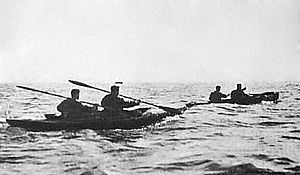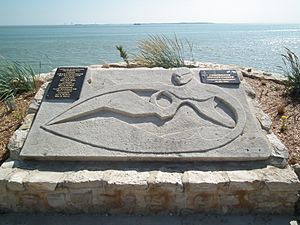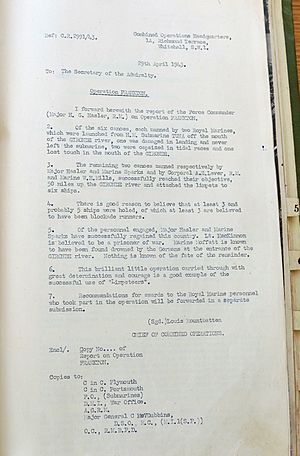Operation Frankton facts for kids
Quick facts for kids Operation Frankton |
|||||||
|---|---|---|---|---|---|---|---|
| Part of Western Front | |||||||
|
|||||||
| Belligerents | |||||||
| Commanders and leaders | |||||||
| Strength | |||||||
| 13 men 6 kayaks ('Cockle' mark 2) |
2 Naval trawlers 12 E Boats 12 Patrol boats 6 M-class minesweepers |
||||||
| Casualties and losses | |||||||
| 6 men captured & executed 2 died from hypothermia |
6 ships damaged | ||||||
Operation Frankton was a daring commando mission during World War II. A small team of Royal Marines attacked German ships in the port of Bordeaux, France. This secret raid happened in December 1942.
The mission was carried out by a special group called the Royal Marines Boom Patrol Detachment (RMBPD). They were part of Combined Operations. A submarine, HMS Tuna, carried them close to the French coast.
The plan was simple but very risky. Six special folding kayaks, called 'Cockles', would be launched from the submarine. Twelve men would paddle them at night towards Bordeaux. Once there, they would attach limpet mines to German cargo ships. These mines would explode and sink the ships. After the attack, the commandos would escape overland to Spain.
Major Herbert 'Blondie' Hasler led the team of 13 men. Sadly, one kayak was damaged, so only five could start the mission. Out of the 10 men who launched from the submarine, only two survived the raid: Major Hasler and Marine Bill Sparks. Six others were captured and executed by the Germans. Two more died from extreme cold.
Contents
The Royal Marines Prepare for Action
The Royal Marines Boom Patrol Detachment (RMBPD) was formed in July 1942. They trained at Southsea, England. Major Herbert Hasler was their leader. The team had 34 men and practiced often in Portsmouth Harbour.
The port of Bordeaux was very important for the German war effort. Many supplies, like oils and rubber, arrived there. Major Hasler suggested a plan to attack these ships in September 1942. His first idea was to use three kayaks. They would travel about 60 miles (97 km) from the sea to Bordeaux. They would paddle at night and hide during the day. Their goal was to sink six to twelve cargo ships. Then, they would escape to Spain.
Permission for the raid was given in October 1942. Admiral Louis Mountbatten, who led Combined Operations, increased the number of kayaks to six. He first said Hasler couldn't go on the raid. But Hasler was the only one with experience in these small boats. So, Mountbatten changed his mind. The RMBPD began intense training. This included handling kayaks, practicing with submarines, using limpet mines, and learning how to escape and avoid capture.
The kayaks chosen were called 'Cockle Mark II'. These were two-man kayaks, about 15 feet (4.6 m) long. They could be folded to fit inside the submarine. Each kayak carried two men, eight limpet mines, paddles, a compass, and other gear. They also had rations and water for six days. The total weight for each kayak was about 480 lb (220 kg). The men also carried a pistol and a knife.
The team was split into two groups, each with different targets:
- A Division
- Hasler and Marine Bill Sparks in kayak Catfish.
- Corporal Albert Laver and Marine William Mills in kayak Crayfish.
- Corporal George Sheard and Marine David Moffatt in kayak Conger.
- B Division
- Lieutenant John Mackinnon and Marine James Conway in kayak Cuttlefish.
- Sergeant Samual Wallace and Marine Robert Ewart in kayak Coalfish.
- Marine W. A. Ellery and Marine E. Fisher in kayak Cachalot.
Marine Norman Colley was the thirteenth man, taken as a reserve.
The Dangerous Mission Begins
Journey to Bordeaux
On November 30, 1942, the Royal Navy submarine HMS Tuna (N94) left Scotland. It carried the six kayaks and the commandos. The submarine reached the Gironde estuary on December 7, 1942. It surfaced about 10 miles (16 km) from the estuary's mouth.
During deployment, the kayak Cachalot was damaged. This meant only five kayaks could start the raid. The reserve Marine Colley stayed on the submarine with the Cachalot crew.
The five kayaks launched around 7:30 PM on December 7. The plan was to paddle for an hour, then rest for five minutes. The first night was tough. Strong tides and winds made paddling very hard. Coalfish disappeared. Then, the remaining crews faced 5 feet (1.5 m) high waves. Conger capsized and had to be sunk because it couldn't be emptied. Its crew, Sheard and Moffatt, held onto other kayaks. They swam to shore when they got close enough. They later met the missing Coalfish and continued.
The remaining kayaks approached a German checkpoint. They saw three German ships. The commandos lay flat in their kayaks and paddled silently. They managed to pass without being seen. However, Mackinnon and Conway in Cuttlefish got separated from the others. They managed to avoid capture for four days. But they were betrayed and arrested by the French police (Gendarmerie). They were handed over to the Germans.
On the first night, the three remaining kayaks, Catfish, Crayfish, and Coalfish, covered 20 miles (32 km). They landed near St Vivien du Medoc. Unknown to the others, Wallace and Ewart in Coalfish were captured at daybreak.
By the end of the second night, December 8/9, Catfish and Crayfish had paddled another 22 miles (35 km). On the third night, December 9/10, they covered 15 miles (24 km). The fourth night, December 10/11, they only managed 9 miles (14 km) due to strong tides. Major Hasler changed the plan. They would hide for another day and attack Bordeaux on the night of December 11/12. They prepared their equipment and limpet mines. The mines were set to explode at 9:00 PM. Hasler decided Catfish would attack the western side of the docks. Crayfish would cover the eastern side.
The Attack on Bordeaux
The two remaining kayaks, Catfish and Crayfish, reached Bordeaux on the fifth night, December 11/12. The river was calm, and the sky was clear. The attack began at 9:00 PM on December 11.
Hasler and Sparks in Catfish attacked ships on the western side. They placed eight limpet mines on four vessels. One of these was a German patrol boat called a Sperrbrecher. A guard on the patrol boat shone his torch towards the water. But the camouflaged kayak was not seen in the darkness. They finished placing their mines and left the harbor at 12:45 AM.
At the same time, Laver and Mills in Crayfish reached the eastern side of the dock. They didn't find any targets there. So, they went to attack ships docked at Bassens. They placed eight limpet mines on two vessels. Five mines went on a large cargo ship, and three on a smaller liner.
On their way downriver, the two kayaks met by chance. They continued together until 6:00 AM. They then beached their kayaks near St Genes de Blaye and tried to hide them by sinking them. The two crews then set out separately on foot for the Spanish border. After two days, Laver and Mills were caught by the Gendarmerie. They were handed over to the Germans.
On December 10, the Germans announced that a sabotage team had been caught. They claimed the team was "finished off in combat." In January 1943, all 10 men on the raid were listed as missing. Later, it was confirmed that five ships in Bordeaux had been damaged by mysterious explosions. New research in 2010 showed a sixth ship was also badly damaged.
Hasler and Sparks reached the French town of Ruffec, 100 miles (160 km) from where they had left their kayak. This was on December 18, 1942. They found help from an escape line leader, Mary Lindell. She and her son helped them hide for 18 days. Lindell then arranged for them to be guided on foot across the Pyrenees mountains into Spain and safety.
After the Raid
It took until February 23, 1943, for Combined Operations Headquarters to learn that Hasler and Sparks were safe. Major Hasler returned to Britain by plane from Gibraltar in April 1943. Marine Sparks returned later by sea.
For their bravery, Major Hasler received the Distinguished Service Order. Marine Sparks received the Distinguished Service Medal (DSM). Laver and Mills were also recommended for the DSM. However, medals could not be given after death at that time. So, they were instead mentioned in despatches, which is a special recognition.
Wallace and Ewart were executed by the Germans on the night of December 11. This happened in a wood north of Bordeaux. They were killed under the "Commando Order." This order meant that captured commandos were to be executed. A small memorial can be seen at the Pointe de Grave, where they were captured. In March 2011, a new memorial was unveiled there.
Mackinnon was in the hospital for an infected knee. Evidence suggests that Laver, Mills, Mackinnon, and Conway were also executed under the Commando Order. The exact date of their execution is not known.
Sheard and Moffatt, from the capsized Conger, did not drown. They died from hypothermia, which is when your body gets too cold. Moffatt's body was found on December 14. Sheard is remembered on a special stone in his hometown.
Remembering the Heroes
Lord Mountbatten, the commander of Combined Operations, praised Operation Frankton. His words are carved into a stone at the Royal Marines Poole headquarters: "Of the many brave and dashing raids carried out by the men of Combined Operations Command none was more courageous or imaginative than Operation Frankton."
Many memorials honor the men of Operation Frankton:
- Mackinnon is remembered on the Portsmouth Naval Memorial.
- A permanent memorial for Royal Marine James Conway was unveiled in his hometown of Stockport in December 2017.
- Laver, Sheard, Mills, Conway, Wallace, Moffatt, and Ewart are remembered on the Plymouth Naval Memorial.
In June 2002, the Frankton Trail was opened. This is a walking path that follows the 100 miles (160 km) route taken by Hasler and Sparks to escape. The Frankton Souvenir is a group that works to keep the story of the raid alive.
A memorial made of Portland Stone was dedicated on March 31, 2011. It honors the Cockleshell Heroes and three French people who helped them.
The only known surviving 'Cockle Mark II' kayak from Operation Frankton, named Cachalot, is on display. You can see it at the Combined Military Services Museum in Maldon, Essex.
In France, the heroes of Operation Frankton are remembered every year. There are ceremonies in places like Bordeaux and Ruffec. Commemorative plaques have been placed in different towns. A tramway station in Blanquefort is even named Frankton.
Stories and Films
In 1955, a film called The Cockleshell Heroes was made about the raid. It was a fictionalized version of the story. The film was very popular. After the film, a book with the same name was published. Major Hasler was involved with both. He disliked the title and tried to make the book more accurate.
In November 2011, a BBC television show called "The Most Courageous Raid of WWII" told the story. It was narrated by Paddy Ashdown, a former officer from the SBS. Ashdown pointed out that there was another secret mission happening at the same time. This mission, led by Claude de Baissac, also aimed to sink ships in Bordeaux. Hasler's team didn't know about it due to secrecy. This lack of cooperation led to new rules to prevent such issues in the future.
In December 2022, ten former Royal Marines recreated the journey. This was part of the Cockleshell 22 project. They paddled over 70 miles (110 km) in folding kayaks. They also did a 100 miles (160 km) speed march, following Hasler and Sparks' escape route. This was done to support charities like the Royal British Legion.




